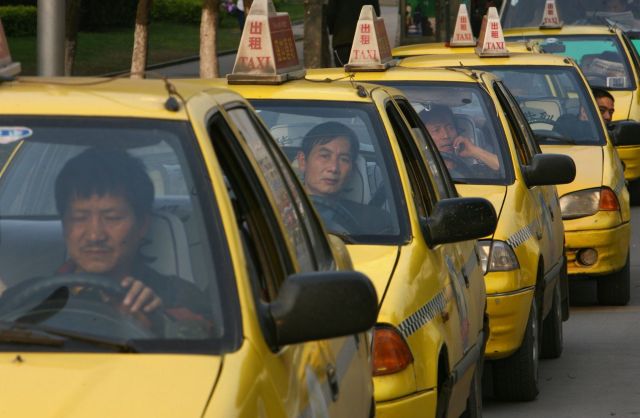Limited lifespan? Taxi drivers in China. Credit: China Photos/Getty

In almost a year of writing these columns, a story I keep coming back to is the advent of the driverless car. Another favourite subject is China – and, in particular, Chinese technology. But today’s UnPacked is the first time I’ve brought these two topics together – and I do so thanks to a must-read piece by Anjani Trivedi for Bloomberg.
Trivedi shows us how automation would transform the economics of road travel:
“Getting rid of drivers cuts costs. Take an American electric car that runs 24 hours a day, seven days a week as part of a ride-sharing network. According to Nissan Motor Co. Chairman Carlos Ghosn, charging the car costs about $250 a month and the lease takes $300 to $400 a month. Because the cars run around the clock, there are three drivers — together they draw $15,000 a month. Eliminate that expense, and this is a very different proposition.”
Now, one could quibble with these figures. For instance, most taxis don’t run 24 hours a day, because there isn’t the round-the-clock demand for it. Therefore, you wouldn’t need to fund three sets of wages. The non-wage costs might also need bumping up a bit. Nevertheless, it is clear that with automation, most of the cost of providing a taxi service disappears.
Therefore, if self-driving cars can be made to work and manufactured for a similar price as conventional vehicles, then the economics of road travel will shift from individual car ownership to hail-and-ride services. As individuals we won’t have to worry about things like maintenance, fuelling, parking, insurance and security, all of that will be done by the service provider.
The opportunities are massive – as are the threats to established industries. Therefore, it’s not surprising that a manufacturing nation like China wants to get ahead of the game.
Trivedi notes a flurry of initiatives in this area from big Chinese tech companies – while also discerning the guiding hand of government industrial policy:
“A lot of this follows a Beijing-mandated push. In April, the government laid out national road-testing guidelines for autonomous vehicles, adding to rules in place in Shanghai and Beijing. That will make it possible for China to collect vast amounts of data on AV testing on public roads, the way Alphabet Inc., Google’s parent, did with its sibling Waymo.”
When the Chinese government decided to back renewable energy in a big way, the country’s productive capacity swung behind the manufacturing of solar panels, wind turbines and batteries. As a result of these economies of scale, prices came tumbling down – helping to transform the economics of the energy sector.
If Chinese manufacturing muscle is applied to the pricier gizmos required to make a driverless car work, then there could be another cost revolution.
Of course, its not just a case of muscle. Automating road transport is a task of great complexity – of which developing and scaling-up the vehicle technology is only a part.
Even assuming that we can produce reliable and affordable self-driving cars, that still leaves the immense challenge of incorporating them into existing transportation networks. Multiple systems will need to be integrated and not just under the bonnet, but across an entire economy and society.
This looks like giving China a further advantage. The country’s leaders are not as likely to come from an engineering background as they once were, but they are systems thinkers – as you have to be when your job is to control the system. The full implementation of driverless technology will not be universally popular. Driverless cars will kill people (in fact, they already have). Furthermore, as human drivers are excluded from some – and, eventually, all – of the road network, there will be bitter opposition. However, Chinese policymakers have ways of overcoming public resistance that aren’t available to their western counterparts.
Perhaps that’s why they feel so confident in putting the country’s resources behind the new technology:
“The sheer amount of capital needed to fund the infrastructure for autonomous vehicles will be far more than many — or any — government is willing to commit just yet, other than China. “
Making the transition to self-driving cars will be a wonder of the age – an achievement on a par with the moon landings (though of much greater significance to everyday life).
If China gets there before the West, it will represent something more than one technology succeeding another.










Join the discussion
Join like minded readers that support our journalism by becoming a paid subscriber
To join the discussion in the comments, become a paid subscriber.
Join like minded readers that support our journalism, read unlimited articles and enjoy other subscriber-only benefits.
Subscribe